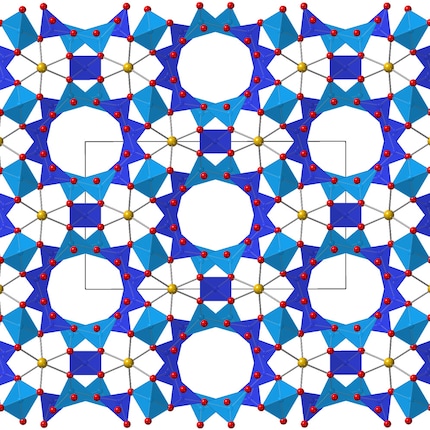
Mystery of the pizza stone solved
The mineral cordierite behaves strangely in the heat of the oven. It expands in two directions and shrinks in the third. Now it is clear why.
Whether water or stone, when substances get warm, they expand. The reason is very simple: the atoms and molecules move more and need more space. However, some materials defy this rule - for example the mineral cordierite, which is also used to make many heat-resistant pizza stones. Cordierite only changes its size slightly, no matter how hot the material gets. It even shrinks in one direction in the oven, while it expands in the other two directions. Martin Dove from Queen Mary University of London and Li Li from the Civil Aviation Flight University of China in Guanghan have deciphered the reasons behind this strange behaviour. As they report in the scientific journal "Matter", two effects work against each other and almost cancel each other out.
In technology, this type of behaviour is sought after for applications at high temperatures. If components repeatedly expand and shrink significantly, this creates stresses that can destroy them. Materials such as cordierite, which hardly change over wide temperature ranges, are therefore much more resistant. However, materials that resist thermal expansion or even contract due to heat are relatively rare. Their atomic structure must have very special properties in order to neutralise the naturally increasingly expansive thermal vibrations of the atoms. How this is achieved in cordierite was previously unknown.

Source: Press image M. Dove and L. Li
Dove and Li came to the conclusion that two effects play a role here. On the one hand, stronger movements can also pull the crystal lattice together - namely when atoms pull the neighbouring atoms towards each other due to their strong thermal vibrations and the distance between them becomes smaller. On the other hand, "joints" in the crystal lattice can transfer the deformation forces to the entire structure so that, for example, ring-shaped structures become oval. They expand in one direction and contract in the other, much like the lattice of a fence when it is stretched lengthwise.
At low temperatures, vibrations of relatively low frequency cause atoms in the crystal to pull their neighbours towards each other. This causes cordierite to shrink slightly in all three spatial directions. If the temperatures continue to rise, the high-frequency vibrations of the atoms are transferred to the crystal lattice via the joints. This reverses and neutralises the shrinkage in two spatial directions. The overall result is that cordierite expands only minimally in the oven and even shrinks a little in one direction. Although these findings only indirectly help to bake a better pizza, they should now help in the search for materials with similar properties.
Spectrum of Science
We are partners of Spektrum der Wissenschaft and want to make well-founded information more accessible to you. Follow Spektrum der Wissenschaft if you like the articles.
Original article on Spektrum.deExperts from science and research report on the latest findings in their fields – competent, authentic and comprehensible.